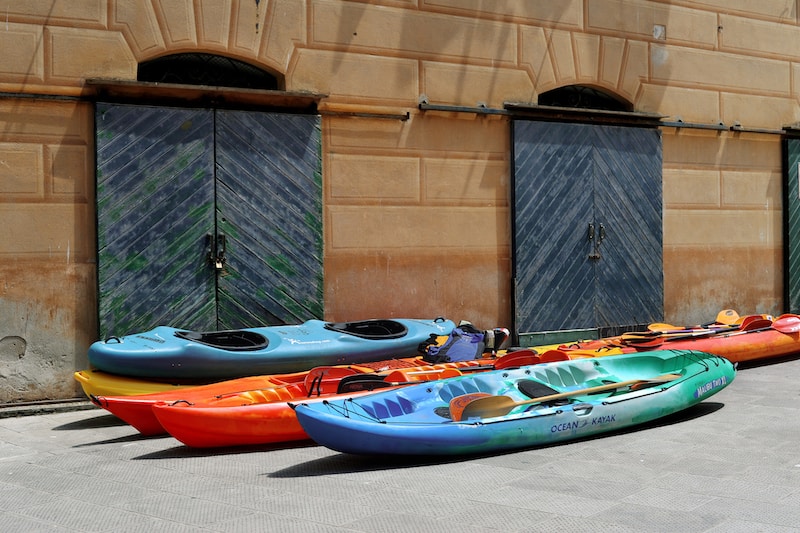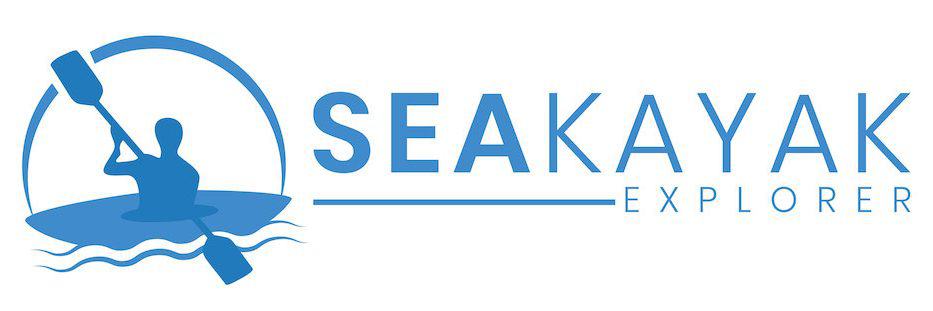How much does a new car cost, or a house? These aren’t easy questions to answer, and kayaks are no different. Their cost depends on several factors. You can pick up a low-quality plastic kayak at your local big-box retailer for under $150. Will it last forever or provide the best paddling experience? Probably not. On the other hand, not everyone needs to spend $4,000 on a state-of-the-art sea kayak to get a high-quality boat they love.
In this post, we’ll discus some of the factors that affect how much a kayak costs so you know what to look for when you’re buying a new kayak.
How Expensive is a Kayak?

Kayak prices vary dramatically, so much so that it’s nearly impossible to provide a meaningful range of prices. The cheapest kayaks, either sit-in or sit-on-top, can be found for under $300. A higher-quality example of the same will cost double that but will likely last decades longer and paddle better, too. Unique or specialty kayaks, like ultra-lightweight touring boats, can cost several thousand dollars.
Types of Kayak and Their Rough Costs
A kayak’s cost depends on the type of boat, its size, the construction materials, and its quality. Here are some random example prices to provide a rough picture of the range.
| Type of Kayak | Example Boat | Approx Cost |
|---|---|---|
| Inflatable Kayaks | Intex Challenger K2 | $200 |
| Inflatable Kayaks | Sea Eagle SE330 | $299 |
| Inflatable Kayaks | Sea Eagle 393RL | $999 |
| Whitewater Kayaks | Pyranha Ripper | $1,449 |
| Whitewater Kayaks | Jackson AntiX | $1,399 |
| Whitewater Kayaks | Dagger Rewind | $1259 |
| Recreational Kayaks | Sun Dolphin Aruba 10 (Rotomolded) | $275 |
| Recreational Kayaks | Eddyline Skylark (ABS) | $1429 |
| Recreational Kayaks | Current Designs Kestral 120 | $899 |
| Fishing Kayaks | Vibe Shearwater 125 (Rotomolded) | $1,399 |
| Fishing Kayaks | Ocean Kayak Trident 15 (Rotomolded) | $1,399 |
| Pedal Kayaks | Hobe Mirage Passport 12 | $1,699 |
| Pedal Kayaks | Ocean Kayak Malibu Pedal | $1,899 |
| Touring/Sea Kayaks | Wilderness Systems Tsunami 175 | $1,729 |
| Touring/Sea Kayaks | Current Designs Solstice GT | $3,999 |
| Special Design | Oru Beach (folding) | $1,199 |
Inflatable Kayaks
Inflatables range in cost from under $100 to over $1000. They come in many shapes and sizes. Their price is primarily determined by the thickness of the material and the complexity of the design. Some inflatables include high-pressure, drop-stitched floors or sides, which are much more complex than standard inflatable parts. A cheap option might be something like the Intex Explorer K2 which can be found for under $200 but it won’t last forever.
Whitewater Kayaks
Whitewater kayaks are sold to a small group of enthusiasts, so the companies that make them are usually smaller. Quality has to be good since they’re going to get banged up a little on the river. Make sure that you check that the kayak is approved for the class of rapids that you’ll be tackling. Otherwise you might find your kayak can’t take the bumps and bashes that’ll inevitably happen along your trip and you’ll end up having to buy a new kayak.
Recreational/General Purpose Kayaks
This group of kayaks probably has the widest variation in price since this is the category that beginner’s kayaks would come from. You can spend anywhere from $300-500 for an introductory recreational kayak. But more expensive models may come with features like additional leg room, storage space and quality materials but you can look to spend over $1200 for these higher end models.
Fishing Kayaks
Fishing kayaks are recreational vessels that come outfitted with extra gear, so they typically cost a lot more. Basic fishing kayaks start at about $500 and go up to around the price of a small car for some models with all sorts or extras like motors, extra storage space, pedals and accessories.
Pedal Drive Systems
One of the most expensive accessories you can get for a kayak is a pedal drive system. These systems usually cost as much as the rest of the boat does. They are very popular among anglers since they can move around the water without using their paddle which keeps their hands free for fishing.
The cost of a pedal kayak will depend on the size and type that you get as well. You can find a few models for under $1000 but it is safe to say these kayaks generally range from $1500-3000 or more.
Touring/Sea Kayaks
Like whitewater boats, touring kayaks are sold to a limited number of enthusiastic customers. They’re people looking for a high-quality product to meet a specific need, so they’re willing to pay a little bit more than most beginners would. These are also the largest style of kayak, so they naturally cost more anyway.
The cheapest touring kayaks start out around $700, but some of the more expensive ones can be priced up to about $4000 for a high end model.
Special, Unique Designs
You’re likely to see some kayaks with features that set them apart from everyone else. This means they aren’t competing on price at all–they’re selling something no one else is. Examples include folding kayaks or skin-on-frame kayaks.
What Causes the Price Differences?

Now that you’ve seen what a considerable variance there is in pricing, you might notice a few patterns. Larger kayaks are more expensive, as those models are suited for niche markets and experienced paddlers. Likewise, the material used to make a kayak makes a considerable price difference.
Materials and Labor to Construct
Rotomolded kayaks are made by taking a liquid plastic and pouring it into a mold. The deck of the kayak has a mold, as does the hull. The two halves are then joined together. This is one of the least expensive ways to make a kayak.
Thermo-molded boats are made with ABS plastic that comes in sheets. It’s heated and pressed into the mold. The two processes of making plastic kayaks are similar, but the ABS material is more expensive and harder to work with. So, ABS kayaks tend to cost more than rotomolded kayaks.
The next level up is a composite kayak. Fiberglass is made from a woven cloth soaked in polyester or epoxy resin, which is quite expensive. But the cost comes in the actual production. For the most part, composite kayaks are built by hand by skilled workers, which takes longer and costs more.
Advanced composites, like carbon fiber or Kevlar, are created with the same lengthy manufacturing process. But the materials are even more expensive. Working with these materials is also more complicated, and workers must take care not to damage them in the process.
Quality and Durability
If a company is price motivated, they will have to figure out how to make the boats cheaply. They can do this by getting low-quality materials and building them overseas where labor costs are low. They may skimp on quality control, too. Will they use materials that will last the customer 20 years or spend less to get materials that will only get most boats past their one or two-year warranty period?
Alternatively, some manufacturers pride themselves on making high-quality boats that will last a lifetime. They aren’t competing for your business based on the lowest price.
These kayak manufacturers exist because there are enough paddlers out there who want a better boat. Do you get what you pay for? In most situations with a kayak, yes, you do. A boat designed by a specialized kayak company tends to have better handling and performance on the water.
Scale of Manufacture
A kayak brand can also make boats less expensive by making a lot of boats. If the company makes other items with similar manufacturing processes, it might cost them less to make kayaks than a shop that does nothing else.
Included Accessories and Outfitting
Finally, the number of accessories included with the kayak will play a factor. A fancy seat and backrest, gear tracks, rod holders, or peddle drive systems–these knick-knacks add to the price tag. This is generally why fishing kayaks are more expensive. They are normal kayaks with a lot of accessories included.
Renting versus Buying

The smartest money you can spend is taking a few paddling trips in different types of rental boats. If you’re new to paddling, it’s impossible to pick between designs without any experience. You’ve got to hit the water and do a least a little paddling!
Try getting experience in kayaks of different designs, brands, and lengths. Try both sit-in and sit-on-tops. If you’re brand new to paddling, you’ll learn a lot and wind up getting a kayak more suited for you in the end.
There are other advantages to renting kayaks besides trying before buying. You can also travel to different destinations, all while not worrying about having to transport a kayak!
Other Accessories and Costs
There are other costs to consider in your kayaking adventure. The most underestimated is the paddle. Good paddles make a world of difference in your experience. A well-designed, lightweight paddle means the difference between fatigue after an hour or all-day fun on the water. A carbon-shaft composite paddle should be a minimum requirement. Expect to pay around $150 for a good paddle, if not double that.
You also have to transport your kayak. Most people put them on a roof rack. Even if your car has a rack built-in, you often need to invest in a crossbar system with hull cradles and straps. It’s easy to spend another few hundred on a rack system.
Then you’ll need a place to keep the kayak at home. Plastic boats, especially polyethylene ones, don’t do well in the sun. Keeping them on a rack in the garage is best, so you’ll want to look into hanging systems and storage solutions.
Conclusion
A kayak is a significant purchase that deserves some time and consideration. Think about renting different boats until you can pin down precisely what you want and like. Expect to pay between $500 and $800 for a high-quality recreational kayak, and be wary of boats that are much cheaper than that.
